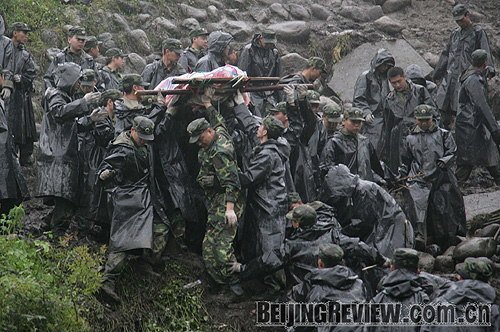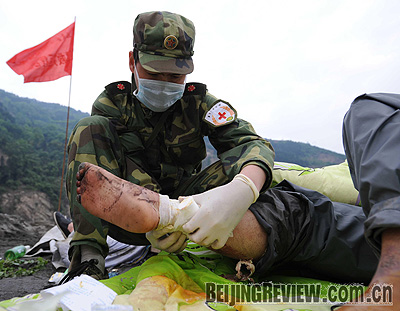|
|

|
|
TO THE RESCUE: Soldiers from the Chengdu Military Area Command repair roads leading to the hardest-hit areas, and evacuate survivors to safer area |
The People's Liberation Army (PLA) and armed police forces reacted quickly in the hours after the worst earthquake to hit China in three decades.
On the morning of May 13, less than 24 hours after the earthquake, a lead team headed by Chen Bingde, Chief of General Staff of the PLA, was formed to lead the recovery and relief efforts.
By early morning on May 15, the PLA and armed police forces had dispatched a total of over 130,000 personnel to Sichuan. Helicopters and military cargo-transport planes flew more than 300 sorties to transport food and rescue troops to areas in need.
On the day the 7.8-magnitude earthquake struck Sichuan, troops quartered around the county immediately dispersed over 13,600 soldiers into the surrounding areas to start the rescue effort.
However, because many roads leading to Wenchuan County were made impassable by the quake, troops were hindered from reaching the epicenter as quickly as possible. Premier Wen Jiabao, rescuer-in-chief, ordered the troops to "strive to get into the epicenter by whatever means, land, air or sea!"
At the service of the people
At 11:15 p.m. on May 13, after a 90-km, 21-hour forced march, Wang Yi, Commander-in-Chief of a unit of armed police forces stationed in Sichuan, together with 600 of his men, became the first to arrive at the epicenter of the disaster. In an interview with Sichuan Online, Wang praised his men for overcoming dangers such as large aftershocks, debris and landslides to arrive at the epicenter on time.
Wang said that the local government had functioned well after the disaster struck and that residents had remained calm. But many became emotional when they saw the soldiers arrive in town, shedding tears and saying they were more confident now that the government had broke their ring of isolation.
PLA Daily reporters on the scene said that when they were hiking with soldiers through the remote mountainous areas affected by the quake, survivors retreating from the epicenter applauded or bowed upon seeing the soldiers. Some even tried giving their food to the soldiers, telling them they could save more lives if they kept their strength.
Among the collapsed buildings, soldiers used their hands to dig out anyone with the slightest chance of being alive. Due to the high pressure involved in the rescue work, many soldiers had not eaten a meal through the entire day, Sichuan TV reported.
Because many of the most damaged areas were inaccessible, the relief effort has been enormous-including the largest airlift, Xinhua News Agency said, in the history of the 2.3-million-member PLA. Beset by heavy rains and a series of aftershocks that have complicated relief efforts, soldiers have in some cases parachuted into areas too isolated to be reached in other ways.
In the noon of May 14, 15 paratroopers descended from 5,000 meters above sea level into one of the hardest-hit areas of Maoxian County, a county neighboring the epicenter. They shouldered the responsibility for establishing communications, providing reconnaissance of the disaster situation and reporting to the decision-makers.
By the end of May 15, soldiers had been deployed into all 58 townships and villages most affected by the quake, sparing no effort to get to the scene quickly.
Nationwide mobilization
China's seven military area commands have all sent troops or medical forces to Sichuan to help in disaster recovery efforts.
In addition to the first 13,600 soldiers dispatched, Chengdu Military Area Command sent 16,000 more soldiers to the quake-hit areas on May 14.
 |
|
UNCOMMON HEROES: Military medical staff venture deep into the remote, quake-devastated mountains to save local residents and treat the injured |
Jinan Military Area Command sent 18,000 soldiers who traveled to Sichuan by railway and motorcycle.
Lanzhou Military Area Command dispatched over 5,000 active and reserve soldiers to lend assistance.
Beijing Military Area Command organized a professional earthquake relief team of 150 soldiers. Armed with the most advanced search and rescue equipment and medical facilities, the unit is very experienced in conducting emergency rescues.
Guangzhou Military Area Command formed three medical teams of altogether 90 medical staff, and transported medical equipment and medicine worth 7 million yuan.
Nanjing Military Area Command formed six medical teams, composed of surgeons and anti-epidemic and disease prevention staff, to deliver medical equipment and medicine worth 1 million yuan ($143,000) by the end of May 14.
Li Jianhua, a high-ranking military officer at the General Logistics Department of PLA, said that by 9 a.m. on May 14, a total of 72 military medical teams made up of 2,160 staff had been dispatched to the area. Li said they transported emergency medicine and medical equipment worth over 37 million yuan ($5.3 million).
Li said that the military would further transport large medical facilities such as ambulances, anti-epidemic vehicles and surgery vehicles to the disaster area. Soon after, another 16 anti-epidemic teams will arrive on the scene.
Meanwhile, the armed police had dispatched over 20,000 soldiers to assist in the rescue work by the end of May 13 and had saved over 3,000 lives.
Zhao Picong, an officer with the Publicity Department of the Chengdu Military Area Command said that his fellow soldiers were pushing ahead with the rescue efforts "at all costs."
"Our troops didn't even assemble. We started off immediately after receiving the order," Zhao said in an interview with China Daily.
"This is no time to hesitate or feel the pressure. It's an extremely urgent situation and we're going into full gear," he added.
Zhao also said he was concerned about a lack of medical staff, poor road conditions, and damaged communications systems. But as reinforcements arrive and infrastructure is restored, rescue efforts would be able to move more efficiently, Zhao said.
The Central Military Commission has also called on the army to view rescue and relief efforts as "the most imperative and significant political task at present."
"All the troops in the relief efforts should break conventions, take exceptional measures, and race against time to get in place as soon as possible," the commission ordered. | 